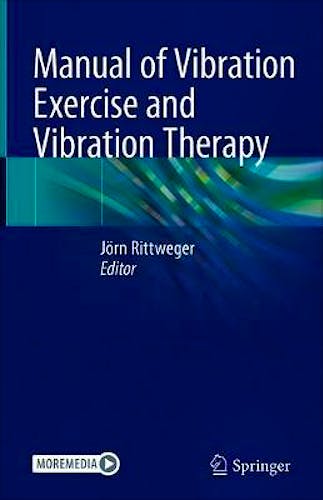

No hay productos en el carrito



Manual of Vibration Exercise and Vibration Therapy
Rittweger, J.
1ª Edición Mayo 2020
Inglés
Tapa dura
396 pags
900 gr
16 x 24 x 2 cm
ISBN 9783030439842
Editorial SPRINGER
LIBRO IMPRESO
-5%
155,99 €148,19 €IVA incluido
149,99 €142,49 €IVA no incluido
Recíbelo en un plazo de
2 - 3 semanas
LIBRO ELECTRÓNICO
-5%
93,59 €88,91 €IVA incluido
89,99 €85,49 €IVA no incluido
Acceso On Line
Inmediato
PART I: THE FUNDAMENTALS
1. Physics of Vibration
2. The Biology of Vibration
3. Design principles of Available machines
4. Safety and contra-indications
PART II: PHYSIOLOGICAL RESPONSES
5. Biomechanics of Vibration Exercise
6. Cutaneous and muscle mechanoreceptors, their sensitivity to mechanical vibrations
7. Electromyographical recordings during Vibration
8. Supraspinal Responses & Spinal Reflexes
9. Assesing reflex latencies in responses to vibration: Evidence for the involvement of more than one receptor
10. Metabolic responses to whole body vibration exercise
11. Circulation Effects
12. Hormonal responses to vibration therapy
PART III: USE OF VIBRATION FOR TRAINING
13. Warming up
14. Modulation of Neuromuscular Function
15. Application in Athletics
16. Using whole body vibration for countermeasure exercise
PART IV: CLINICAL APPLICATIONS
17. How to Design Exercise Sessions with Whole Body Vibration Platforms
18. Whole Body Vibration in Geriatric Rehabilitation
19. Application of vibration training for enhancing bone strength
20. Whole body vibration exercise as a treatment option for chronic lower back pain
21. Pediatric Rehabilitation
22. Chronic Obstructive Pulmonary Disease (COPD)
23. Urinary Incontinence
24. Primary Muscle Disorders
25. Application of vibration training in people with common neurological disorders
26. Whole body vibration therapy in patients with pulmonary hypertension and right heart failure: Lessons from a pilot study
27. Vibration exercise and vibration therapy in metabolic syndrome
28. Whole body vibration exercise in Cancer
GLOSSARY, APPENDICES.
This book addresses the practical aspects of vibration exercise and vibration therapy. In addition, it describes the technical and physiological background, providing applied scientists and doctors with a deeper understanding of the therapeutic potential that vibration exercise holds. Having first emerged two decades ago, vibration exercise has since established itself as a widespread form of physical exercise, used in all rehabilitation areas. The goal of this book is to close the gap between scientific knowledge and practice.Given that occupational exposure to vibration leads to well-known unfavorable effects, the book is also dedicated to potential risks, hazards and contra-indications and of course, the application of vibration therapy in a number of specific conditions is presented in a clinically usable fashion.
Given its breadth of coverage, this book will be of interest to physiotherapists and exercise scientists, but also to a wider range of physicians working in the field of rehabilitation.
Author Information
Joern Rittweger has been a pioneer in the study of vibration as an exercise modality. For the past 20 years, he has been studying the mechanical and physiological effects of vibration, as well as its suitability in preventive and rehabilitative medicine and athletics. As an MD with specialization in physiology, he bridges the gap between fundamental research and clinical application. His primary affiliation is with the German Aerospace Center (DLR), where he heads the 'Muscle and Bone Metabolism' department of the DLR's Institute of Aerospace Medicine. His secondary affiliation is with the University of Cologne, where he is a full professor at the Department of Pediatric and Adolescent Medicine. Dr. Rittweger has published more than 200 scientific articles in peer-reviewed journals, currently holds one patent, and regularly offers training for young scientists and doctors in human physiology.
© 2025 Axón Librería S.L.
2.149.0